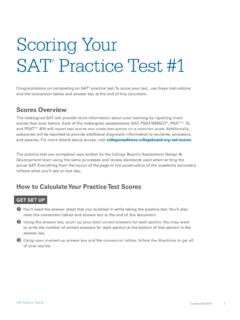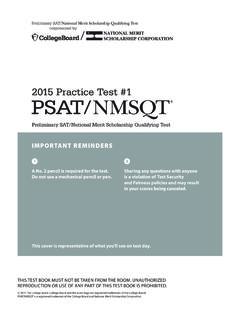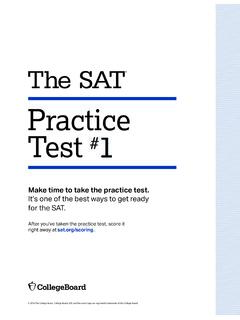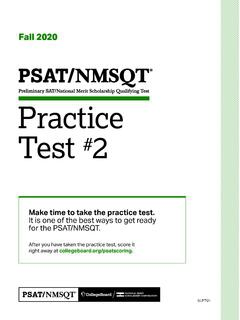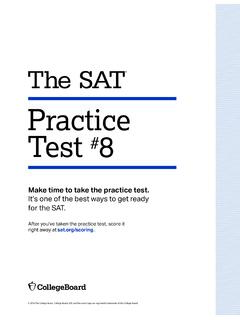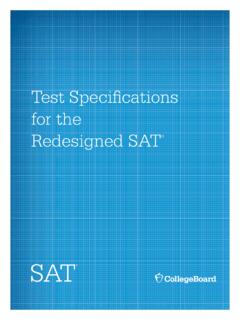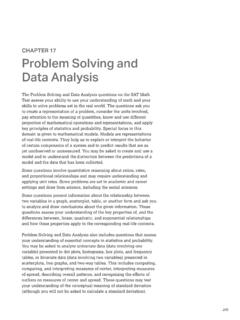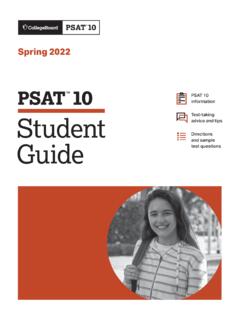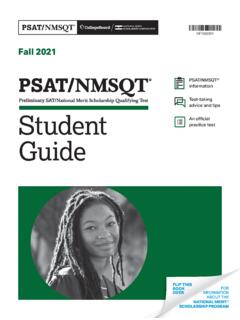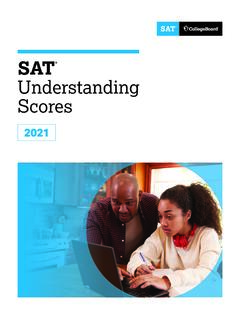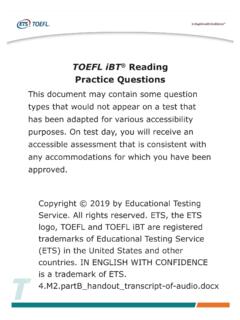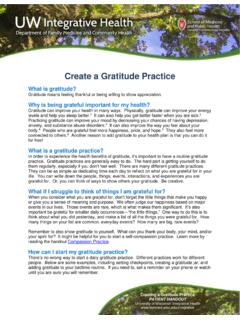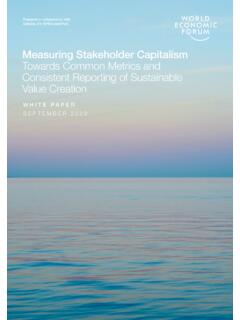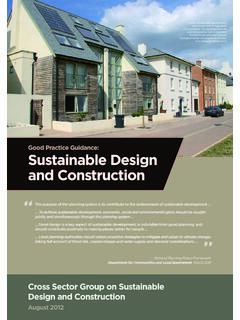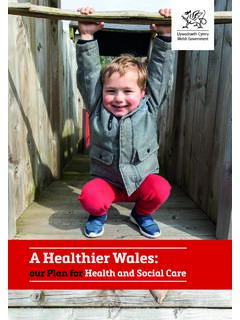Transcription of CHAPTER 9 Sample Reading Test Questions - SAT Suite of ...
1 71 CHAPTER 9 Sample Reading Test QuestionsIn Chapters 5 to 8, you learned about the basic elements of the SAT Reading Test, including the types of passages you ll encounter and the types of Questions the test will include. In this CHAPTER , you ll find five Sample passages and associated test Questions . Following each question is an explanation for the best answer and some comments about the incorrect answer instructions will precede the SAT Reading Test. REMEMBERT here will be four single passages and one set of paired passages on the Reading Test. Passages are drawn from and world literature, history/social studies, and MINUTES, 52 QUESTIONSTurn to Section 1 of your answer sheet to answer the Questions in this passage or pair of passages below is followed by a number of Questions . After readingeach passage or pair, choose the best answer to each question based on what is stated orimplied in the passage or passages and in any accompanying graphics (such as a table orgraph).
2 Questions 1-10 are based on the passage is adapted from MacDonald Harris,The Balloonist. 2011 by The Estate of Donald the summer of 1897, the narrator of this story, afictional Swedish scientist, has set out for the North Polein a hydrogen-powered emotions are complicated and notreadily verifiable. I feel a vast yearning that issimultaneously a pleasure and a pain. I am certainof the consummation of this yearning, but I don tknow yet what form it will take, since I do notunderstand quite what it is that the yearning the first time there is borne in upon me the fulltruth of what I myself said to the doctor only an hourago: that my motives in this undertaking are notentirely clear. For years, for a lifetime, the machineryof my destiny has worked in secret to prepare for thismoment; its clockwork has moved exactly towardthis time and place and no other.
3 Rising slowly fromthe earth that bore me and gave me sustenance, I amcarried helplessly toward an uninhabited and hostile,or at best indifferent, part of the earth, littered withthe bones of explorers and the wrecks of ships, frozensupply caches, messages scrawled with chilled fingersand hidden in cairns that no eye will ever has succeeded in this thing, and many havedied. Yet in freely willing this enterprise, in choosingthis moment and no other when the south windwill carry me exactly northward at a velocity ofeight knots, I have converted the machinery of mythis is carried out. What I don t understand is why Iam so intent on going to this particular place. Whowants the North Pole! What good is it! Can you eatit? Will it carry you from Gothenburg to Malm likea railway? The Danish ministers have declared fromtheir pulpits that participation in polar expeditions isbeneficial to the soul s eternal well-being, or so I readin a newspaper.
4 It isn t clear how this doctrine is tobe interpreted, except that the Pole is somethingdifficult or impossible to attain which mustnevertheless be sought for, because man iscondemned to seek out and know everythingwhether or not the knowledge gives him pleasure. Inshort, it is the same unthinking lust for knowledgethat drove our First Parents out of the suppose you were to find it in spite of all, thiswonderful place that everybody is so anxious to standon!Whatwould you find? Exactly point precisely identical to all the others in acompletely featureless wasteland stretching around itfor hundreds of miles. It is an abstraction, amathematical fiction. No one but a Swedish madmancould take the slightest interest in it. Here I am. Thewind is still from the south, bearing us steadilynorthward at the speed of a trotting dog.
5 Behind us,perhaps forever, lie the Cities of Men with copying or reuse of any part of this page is into the servant of my will. All this I understand,as I understand each detail of the technique by which25 Sample 1:History/Social Studies Passage, Lower Text ComplexityThe following passage on commuting is of lower complexity, although some aspects of the passage are more challenging than others (as is generally true of the published materials you read). This passage is accompanied by an informational text complexity of the passages will range from grades 9 10 to postsecondary entry levels. PART 2 | Evidence-Based Reading and Writing72 Questions 1-3 are based on the following passage and supplementary passage is adapted from Richard Florida, The Great Reset. 2010 by Richard Florida. In today s idea-driven economy, the cost of time is what really matters.
6 With the constant pressure to innovate, it makes little sense to waste countless collective hours commuting. So, the most efficient and productive regions are those in which people are thinking and working not sitting in traffic. The auto-dependent transportation system has reached its limit in most major cities and megaregions. Commuting by car is among the least efficient of all our activities not to mention among the least enjoyable, according to detailed research by the Nobel Prize winning economist Daniel Kahneman and his colleagues. Though one might think that the economic crisis beginning in 2007 would have reduced traffic (high unemployment means fewer workers traveling to and from work), the opposite has been true. Average commutes have lengthened, and congestion has gotten worse, if anything.
7 The average commute rose in 2008 to minutes, erasing years of decreases to stand at the level of 2000, as people had to leave home earlier in the morning to pick up friends for their ride to work or to catch a bus or subway train, according to the Census Bureau, which collects the figures. And those are average figures. Commutes are far longer in the big West Coast cities of Los Angeles and San Francisco and the East Coast cities of New York, Philadelphia, Baltimore, and Washington, In many of these cities, gridlock has become the norm, not just at rush hour but all day, every day. The costs are astounding. In Los Angeles, congestion eats up more than 485 million working hours a year; that s seventy hours, or nearly two weeks, of full-time work per commuter. In , the time cost of congestion is sixty-two hours per worker per year.
8 In New York it s forty-four hours. Average it out, and the time cost across America s thirteen biggest city regions is fifty-one hours per worker per year. Across the country, commuting wastes billion hours of work time annually nearly a full workweek for every commuter. The overall cost to the economy is nearly $90 billion when lost productivity and wasted fuel are taken into account. At the Martin prosperity Institute, we calculate that every minute shaved off America s commuting time is worth $ billion in value added to the economy. The numbers add up fast: five minutes is worth $ billion; ten minutes, $195 billion; fifteen minutes, $292 9 | Sample Reading Test Questions73 It s ironic that so many people still believe the main remedy for traffic congestion is to build more roads and highways, which of course only makes the problem worse.
9 New roads generate higher levels of induced traffic, that is, new roads just invite drivers to drive more and lure people who take mass transit back to their cars. Eventually, we end up with more clogged roads rather than a long-term improvement in traffic flow. The coming decades will likely see more intense clustering of jobs, innovation, and productivity in a smaller number of bigger cities and city-regions. Some regions could end up bloated beyond the capacity of their infrastructure, while others struggle, their promise stymied by inadequate human or other from Adam Werbach, The American Commuter Spends 38 Hours a Year Stuck in Traffic. 2013 by The history/social studies passage and one science passage will be accompanied by an informational graphic such as a table, graph, or passage most strongly suggests that researchers at the Martin prosperity Institute share which assumption?
10 A) Employees who work from home are more valuable to their employers than employees who ) Employees whose commutes are shortened will use the time saved to do additional productive work for their ) Employees can conduct business activities, such as composing memos or joining conference calls, while ) Employees who have longer commutes tend to make more money than employees who have shorter : RhetoricKey: B455055 Objective: Yo u must reasonably infer an assumption that is implied in the 2 | Evidence-Based Reading and Writing74 Explanation: Choice B is the best answer because details in the third paragraph (lines 28-43) strongly suggest that researchers ( we ) at the Martin prosperity Institute assume that shorter commutes will lead to more productive time for workers. The author notes that across the country, commuting wastes billion hours of work time annually and that the overall cost to the economy is nearly $90 billion when lost productivity and wasted fuel are taken into account (lines 34-38).
